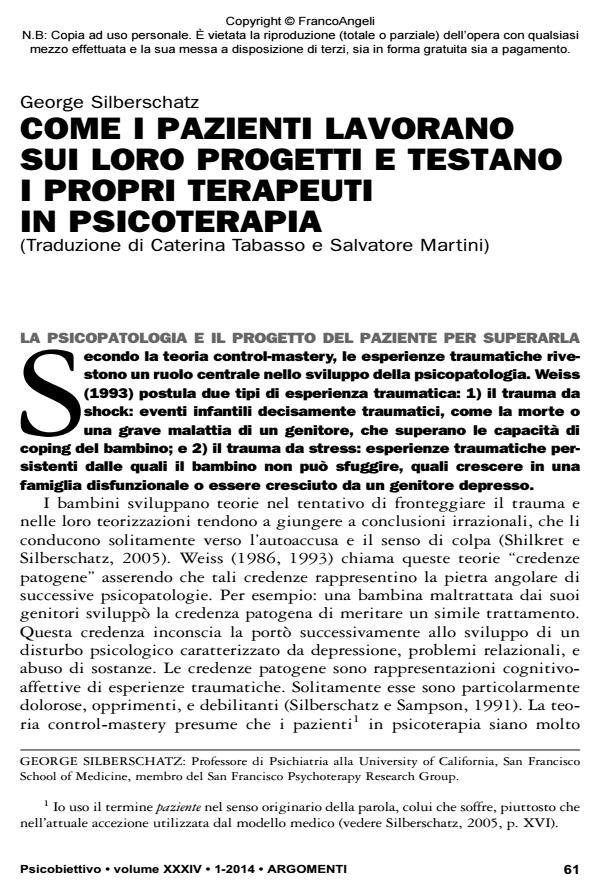Come i pazienti lavorano sui loro progetti e testano i propri terapeuti in psicoterapia
Titolo Rivista PSICOBIETTIVO
Autori/Curatori George Silberschatz
Anno di pubblicazione 2014 Fascicolo 2014/1
Lingua Italiano Numero pagine 11 P. 61-71 Dimensione file 539 KB
DOI 10.3280/PSOB2014-001005
Il DOI è il codice a barre della proprietà intellettuale: per saperne di più
clicca qui
Qui sotto puoi vedere in anteprima la prima pagina di questo articolo.
Se questo articolo ti interessa, lo puoi acquistare (e scaricare in formato pdf) seguendo le facili indicazioni per acquistare il download credit. Acquista Download Credits per scaricare questo Articolo in formato PDF

FrancoAngeli è membro della Publishers International Linking Association, Inc (PILA)associazione indipendente e non profit per facilitare (attraverso i servizi tecnologici implementati da CrossRef.org) l’accesso degli studiosi ai contenuti digitali nelle pubblicazioni professionali e scientifiche
La psicopatologia deriva da esperienze traumatiche infantili che frequentemente conducono allo sviluppo di credenze inconsce patogene. I pazienti intraprendono una psicoterapia con l’obiettivo inconscio di smentire tali credenze. Ci sono tre vie principali attraverso le quali essi possono farlo: 1) usando la relazione terapeutica in quanto tale; 2) usando nuove acquisizioni o insight veicolati dalle interpretazioni del terapeuta; o 3) sottoponendo direttamente il terapeuta a delle prove. Esistono due differenti strategie di prova: 1) attraverso un test transferale, il paziente cerca di valutare se il terapeuta lo traumatizzerà come - il paziente - è stato traumatizzato nell’infanzia; 2) nel test del rivolgimento da passivo ad attivo, il paziente traumatizza il terapeuta come egli stesso è stato traumatizzato, nel tentativo di superare il trauma. I pazienti sono altamente motivati a smentire le loro credenze patogene. Tipicamente devono "testare" il terapeuta nel corso di tutto il trattamento per poterlo fare.
Parole chiave:Teoria control-mastery; teoria psicodinamica; psicoterapia.
- Weiss J. (1986) “Theory and clinical observations”, in J. Weiss, H. Sampson, e The Mount Zion Psychotherapy Research Group (eds.), The psychoanalytic process: Theory, clinical observation, and empirical research, Guilford Press, New York, pp. 3-138
- Weiss J. (1993) How psychotherapy works, Guilford Press, New York
- Bugas J., Silberschatz G. (2005) “How patients coach their therapists in psychotherapy”, in G. Silberschatz (ed.), Transformative relationships: The controlmastery theory of psychotherapy, Routledge, New York, pp. 153-167
- Curtis J.T., Silberschatz G. (2005) “The assessment of pathogenic beliefs”, in G. Silberschatz (ed.), Transformative relationships: The control-mastery theory of psychotherapy, Routledge, New York, pp. 69-91
- Curtis J.T., Silberschatz G. (2007) “Plan formulation method”, in T.D. Eells (ed.), Handbook of psychotherapy case formulation, Guilford Press, New York, 2nd ed., pp. 198-220
- Sampson H. (1976) “A critique of certain traditional concepts in the psychoanalytic theory of therapy”, Bulletin of the Menninger Clinic, 40, 255-262
- Sampson H. (1991) “Experience and insight in the resolution of transferences”, Contemporary Psychoanalysis, 27, 200-207
- Sampson H. (1992) “The role of ‘real’ experience in psychopathology and treatment”, Psychoanalytic Dialogues, 2, 509-528
- Sampson H. (2005) “Treatment by attitudes”, in G. Silberschatz (ed.),
- Transformative relationships: The control-mastery theory of psychotherapy, Routledge, New York, pp. 111-119
- Shilkret C.J. (2006) “Endangered by interpretations: Treatment by attitude of the narcissistically vulnerable patient”, Psychoanalytic Psychology, 23, 30-42 Shilkret R., Silberschatz S.A. (2005) “A developmental basis for controlmastery theory”, in G. Silberschatz (ed.), Transformative relationships: The control-mastery theory of psychotherapy, Routledge, New York, pp. 171-187
- Silberschatz G. (1986) “Testing pathogenic beliefs”, in J. Weiss, H. Sampson, e The Mount Zion Psychotherapy Research Group (eds.), The psychoanalytic process: Theory, clinical observation, and empirical research, Guilford Press, New York, pp. 256-266
- Silberschatz G. (2005) Transformative relationships: The control-mastery theory of psychotherapy, Routledge, New York
- Silberschatz G., Curtis J.T. (1986) “Clinical implications of research on brief dynamic psychotherapy: II. How the therapist helps or hinders therapeutic progress”, Psychoanalytic Psychology, 3, 27-37
- Silberschatz G., Curtis J.T. (1993) “Measuring the therapist’s impact on the patient’s therapeutic progress”, Journal of Consulting and Clinical Psychology, 61, 403-411
- Silberschatz G., Curtis J.T., Nathans S. (1989) “Using the patient’s plan to assess progress in psychotherapy”, Psychotherapy: Theory, Research, Practice, Training, 26, 40-46
- Silberschatz G., Fretter P.B., Curtis J.T. (1986) “How do interpretations
- influence the process of psychotherapy?”, Journal of Consulting and Clinical Psychology, 54, 646-652
- Silberschatz G., Itzhar-Nabarro Z., Badger S. (2007) Psychotherapy case formulation from the perspective of control-mastery theory (Training DVD available from the San Francisco Psychotherapy Research Group: www.SFPRG.org)
- Silberschatz G., Sampson H. (1991) “Affects in psychopathology and psychotherapy”, in J.D. Safran e L.S. Greenberg (eds.), Emotion, psychotherapy, and change, Guilford Press, New York, pp. 113-129
George Silberschatz, Come i pazienti lavorano sui loro progetti e testano i propri terapeuti in psicoterapia in "PSICOBIETTIVO" 1/2014, pp 61-71, DOI: 10.3280/PSOB2014-001005